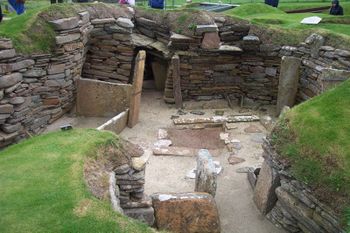القرن 32 ق.م.
(تم التحويل من 3111 ق.م.)
| الألفية: | الألفية 4 ق.م. |
|---|---|
| القرون: | |
| خطوط زمنية: | |
| زعماء الدول: |
|
| العقود: |
|
| التصنيفات: | المواليد – الوفيات التأسيسات – الانحلالات |
القرن 32 ق.م. هو قرن يبدأ من 3200 ق.م. إلى 3101 ق.م.
أحداث
- ح. 3200 ق.م. الملك إري حور يتولى الحكم في أبيدوس، مصر.
- ح. 3200-3150 ق.م. الملك كان يتولى حكم مصر القديمة.
- ح. 3150 ق.م.: نعرمر (مينا في بعض القوائم المبكرة)، أول فرعون يوحد مصر القديمة.
- ح. 3125 ق.م.: وفاة نعرمر.
- 3102 ق.م.: بداية كالي يوگا.
- ڤارنا نكروپوليس: التي يزعم أنها أول المصنوعات الذهبية المعروفة في العالم.
- مالطا: Construction of the Ħaġar Qim megalithic temples, featuring both solar and lunar alignments. "Tarxien period" of megalithic temple construction reaches its apex.
- مصر القديمة: الهيروغليفية المصرية المبكرة المعروفة، بداية عصر الأسر المبكرة.
- كريت: بزوع الحضارة المينوية.
- Neolithic settlement built at Skara Brae in the Orkney Islands, Scotland. (pictured)
- شعوب العصر الحجري الجديد في أيرنلدا قاموا ببناء 250,000 طن (226,796.2 طن) Newgrange solar oriented passage tomb.
- ح. 3100 ق.م: The earliest phase of Stonehenge construction begins.
مشاهير القرن
عصور التقويم
- 3114 BC —According to the most widely accepted correlations between the Western calendar and the calendar systems of pre-Columbian Mesoamerica, the mythical starting point of the Mesoamerican Long Count calendar cycle occurs in this year.[2] The Long Count calendar, used and refined most notably by the Maya civilization but also attested in some other (earlier) Mesoamerican cultures, consisted of a series of interlocked cycles or periods of day-counts, which mapped out a linear sequence of days from a notional starting point. The system originated sometime in the Mid- to Late Preclassic period of Mesoamerican chronology, during the latter half of the 1st millennium BC.[3] The starting point of the most commonly used highest-order cycle[4]—the b'ak'tun-cycle consisting of thirteen b'ak'tuns of 144,000 days each—was projected back to an earlier, mythical date. This date is equivalent to 11 August 3114 BC in the proleptic Gregorian calendar (or 6 September in the proleptic Julian calendar), using the correlation known as the "Goodman-Martínez-Thompson (GMT) correlation". The GMT-correlation is worked out with the Long Count starting date equivalent to the Julian Day Number (JDN) equal to 584283, and is accepted by most Mayanist scholars as providing the best fit with the ethnohistorical data.[1] Two succeeding dates, the 12th and 13 August (Gregorian) have also been supported, with the 13th (JDN = 584285, the "astronomical" or "Lounsbury" correlation) attracting significant support as according better with astronomical observational data.[5] Although it is still contended which of these three dates forms the actual starting base of the Long Count, the correlation to one of this triad of dates is definitively accepted by almost all contemporary Mayanists. All other earlier or later correlation proposals are now discounted.[1] The end of the thirteenth baktun was either on December 21 or 23 of 2012 (supposed end of the world).
الهوامش
- ^ أ ب ت See survey by Finley (2002).
- ^ See Finley (2002), Houston (1989, pp.49–51), Miller and Taube (1993, pp.50–52), Schele and Freidel (1990, pp.430 et seq.), Voss (2006, p.138), Wagner (2006, pp.281–283). Note that Houston 1989 mistakenly writes "3113 BC" (when "-3113" is meant), and Miller and Taube 1993's mention of "2 August" is a (presumed) erratum.
- ^ Miller and Taube (1993, p.50), Schele and Freidel (1990)
- ^ Most commonly used in the Classic period Maya inscriptions; some other Maya calendar inscriptions of this period note even longer cycles, while later Postclassic-era inscriptions in Maya cities of northern Yucatán generally used an abbreviated form known as the Short Count. See Miller and Taube (1993, p.50); Voss (2006, p.138).
- ^ After a modified proposal championed by Floyd Lounsbury; sources that have used this 584285 correlation include Houston (1989, p.51), and in particular Schele and Freidel (1990, pp.430 et seq.). See also commentary by Finley (2002), who although making an assessment that the "[584285 correlation] is now more popular with Mayanists", expresses a personal preference for the 584283 correlation.
المصادر
- Finley, Michael (2002). "The Correlation Question". The Real Maya Prophecies: Astronomy in the Inscriptions and Codices. Maya Astronomy. Archived from the original on 2007-05-30. Retrieved 2007-06-04.
- Miller, Mary (1993). The Gods and Symbols of Ancient Mexico and the Maya. London: Thames and Hudson. ISBN 0-500-05068-6.
{{cite book}}: Unknown parameter|coauthors=ignored (|author=suggested) (help) - Schele, Linda (1990). A Forest of Kings: The Untold Story of the Ancient Maya. New York: William Morrow. ISBN 0-688-07456-1.
{{cite book}}: Unknown parameter|coauthors=ignored (|author=suggested) (help) - Voss, Alexander (2006). "Astronomy and Mathematics". In Nikolai Grube (Ed.) (ed.). Maya: Divine Kings of the Rain Forest. Eva Eggebrecht and Matthias Seidel (assistant eds.). Cologne: Könemann Press. pp. 130–143. ISBN 3-8331-1957-8. OCLC 71165439.
- Wagner, Elizabeth (2006). "Maya Creation Myths and Cosmography". In Nikolai Grube (ed.) (ed.). Maya: Divine Kings of the Rain Forest. Eva Eggebrecht and Matthias Seidel (Assistant Eds.). Cologne: Könemann Press. pp. 280–293. ISBN 3-8331-1957-8. OCLC 71165439.
{{cite book}}:|editor=has generic name (help)
